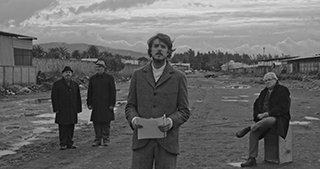Notes for a Film
Notas para una película- CHILE, FRANCE / 2022 / Spanish, French, Mapudungun / Color, B&W / DCP/ 104 min
 Director, Script: Ignacio Agüero
Director, Script: Ignacio Agüero
Photography: David Bravo
Editing: Claudio Aguilar, Ignacio Agüero, Jacques Comets
Sound: Carlo Sanchez
Producers: Tehani Staiger, Viviana Erpel, Elisa Sepulveda, Amalric de Pontcharra
Source: Aguero & Asociado ltd., Fulgurance Films
Ninteenth century Araucania, land of the indigenous Mapuche people, when it had just become a part of Chile. Gustave Verniory was appointed to come from Belgium and work as an engineer in constructing a railroad. The director recounts adventures of bygone days by enlisting actors to retrace Verniory’s footsteps, following his diary. The film also shows the ongoing land struggles in the Mapuche community which still bears the deep scars of colonization, as the narrative shitts back and forth between the relics of the railroad, the landscape and its people, with the crew and the director moving freely in and out of the frame as well as across time. By looking equally at the memories embedded in Araucanian land and the experiences of individuals living in the present, the film implements a new approach both to the world and to cinema. (HH)
[Director’s Statement] When Gustave Verniory arrives in Chile to work as an engineer on the railroad construction in the Araucania territory, in the south of the country, he gets off at a station—Angol Station—which no longer exists. He travels in the past and aboard the present. In between, everything he built at the end of the 19th century was destroyed as soon as Pinochet’s dictatorship began. If this had been fiction, Verniory would have arrived, in the film, at a station reconstructed by set builders. But it is a documentary, so he arrives at a station in ruins.
Based on the texts from the book Ten Years in Araucania, Verniory’s diary, the film explores, through the character as well as through the actor portraying him, the railroad’s penetration of the wilderness and the introduction of capitalism into Chile’s indigenous territory. It does so with the economics of a documentary: period clothing for just one person, a single horse, and a film crew that simultaneously act as both crew members and extras.
Thus, the film is able to explore history through the cinema’s playful possibilities, becoming a fascinating experience for those making it as well as those watching.
 Ignacio Agüero
Ignacio AgüeroBorn in Santiago, 1952. Studied architecture and cinema. Presently a film professor at the University of Chile and a member of the network “Cero en Conducta,” which organizes film workshops for children. He has made numerous documentary films since 1974 for which he has won many awards. Retrospectives of his films have been held in Europe and America. He was present at the first edition of YIDFF in 1989 with his film One Hundred Children Waiting for a Train. He is currently working on his next film, Cartas a mis padres muertos (Letters to My Dead Parents).
